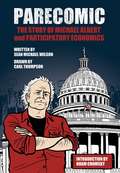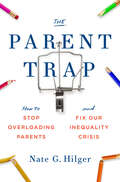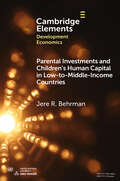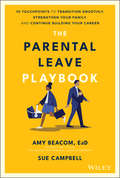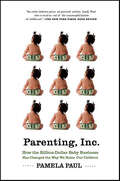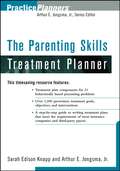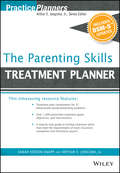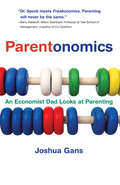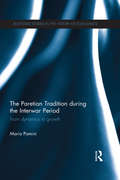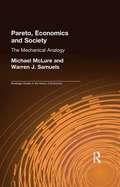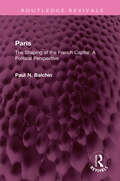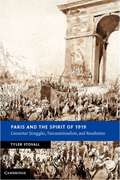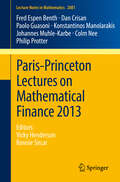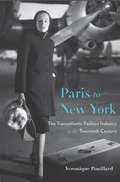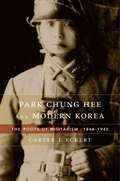- Table View
- List View
Parecomic: Michael Albert and the Story of Participatory Economics
by Noam Chomsky Sean Michael Wilson Carl ThompsonParecomic is a graphic novel about the system we live in--what's wrong with it, and how we might be able change it for the better. The recent upsurge in popular protest around the world shows that people are not happy with the state of capitalism and desire an alternative that will work for the 99%, not just the 1%. Parecon is one such alternative, and Parecomic brings this to life in illustrated form. Parecomic is about Michael Albert--the visionary behind "participatory economics"--and his life's struggle as a left-wing activist in the US, beginning with the heady days of 1960s student demos and lifestyle rebellions; following the developments of the antiwar, civil rights, woman's, and Black Panthers movements; to the establishment of alternative media like South End Press and ZNet; and the development of the participatory economics model. and Black Panthers movements; to the establishment of alternative media like South End Press and ZNet.The recent upsurge in popular protest in the US and around the world shows that people are not happy with the state of capitalism. The Occupy movement, particularly, makes plain the desire for a better system, a model that will work for the 99%, not just the 1%. Parecon is one such model, and Parecomic brings this to life in illustrated form. <P><P> <i>Advisory: Bookshare has learned that this book offers only partial accessibility. We have kept it in the collection because it is useful for some of our members. Benetech is actively working on projects to improve accessibility issues such as these.</i>
Parejas felices, cuentas en orden: 5 pasos para tu armonía financiera
by Elaine KingUn plan estratrégico que ayuda a la parejas a fortalecer su relación por medio de una administración financiera inteligente y planificada.Vivir en pareja es un paso muy importante en la vida de todo ser humano, es suficientemente misterioso comprendernos a nosotros mismos, imagi´nate lo interesante que será entender a tu pareja.Cada persona posee una base de datos, depo´sitos de valores, experiencias, tendencias y actitudes hacia la vida y el dinero. Se dice que el 50% de las parejas que se casan terminan divorciándose, y el 70% de las parejas que se divorcian, lo hacen debido a algo que empezo´ con un manlentendido financiero.Es imprescindible romper ese ciclo y prevenir que más parejas se separen por algo que puede mejorarse. Es por eso que las parejas de hoy deben tener un kit de sobrevivencia para enfrentar cualquier situación. Con preparacio´n y capacitacio´n adecuada, las parejas pueden incrementar las probabilidades de permanecer juntos por muchos años con un entendimiento mutuo del propo´sito del dinero de acuerdo a los valores de ambos.
Las parejas inteligentes enriquecen juntas
by Gustavo Cerbasi¿Cuándo fuela última vez que usted y su cónyuge hablaron de sus finanzas?Hoy en día demasiados cónyuges no se sientan juntos para evaluar susfinanzas. Muchasveces a las esposas se les ha delegado el complejo deber de balancear,manejary pagar las cuentas. La falta de comunicación en las finanzas tambiénse refleja en la comunicación del matrimonio. Muchas veces las familiasque por fuera parecentenerlo todo bajo control, por dentro están completamente enbancarrota. Gustavo Cerbasiayuda a guiar a las parejas, combinando tanto la teoría como losejercicios prácticos, mientras comunican, planifican y funcionanfinancieramente como una unidad familiar.
The Parent Trap: How to Stop Overloading Parents and Fix Our Inequality Crisis
by Nate G. HilgerHow parents have been set up to fail, and why helping them succeed is the key to achieving a fair and prosperous society.Few people realize that raising children is the single largest industry in the United States. Yet this vital work receives little political support, and its primary workers—parents—labor in isolation. If they ask for help, they are made to feel inadequate; there is no centralized organization to represent their interests; and there is virtually nothing spent on research and development to help them achieve their goals. It&’s almost as if parents are set up to fail—and the result is lost opportunities that limit children&’s success and make us all worse off. In The Parent Trap, Nate Hilger combines cutting-edge social science research, revealing historical case studies, and on-the-ground investigation to recast parenting as the hidden crucible of inequality. Parents are expected not only to care for their children but to help them develop the skills they will need to thrive in today&’s socioeconomic reality—but most parents, including even the most caring parents on the planet, are not trained in skill development and lack the resources to get help. How do we fix this? The solution, Hilger argues, is to ask less of parents, not more. America should consider child development a public investment with a monumental payoff. We need a program like Medicare—call it Familycare—to drive this investment. To make it happen, parents need to organize to wield their political power on behalf of children—who will always be the largest bloc of disenfranchised people in this country. The Parent Trap exposes the true costs of our society&’s unrealistic expectations around parenting and lays out a profoundly hopeful blueprint for reform.
Parental Investments and Children's Human Capital in Low-to-Middle-Income Countries (Elements in Development Economics)
by Jere R. BehrmanThis Element reviews what we know about parental investments and children's human capital in low-to-middle-income countries (LMICs). First, it presents definitions and a simple analytical framework; then discusses determinants of children's human capital in the form of cognitive skills, socioemotional skills and physical and mental health; then reviews estimates of impacts of these forms of human capital; next considers the implications of such estimates for inequality and poverty; and concludes with a summary suggesting some positive impacts of parental investments on children's human capital in LMICs and a discussion of gaps in the literature pertaining to both data and methodology. This title is also available as Open Access on Cambridge Core.
The Parental Leave Playbook: 10 Touchpoints to Transition Smoothly, Strengthen Your Family, and Continue Building your Career
by Amy Beacom Sue CampbellSupport your growing family without losing professional ground—a proven approach The Parental Leave Playbook helps parents take control of their leave and make the most of what's considered a career timeout, but is actually a vital "time-in" for your life. If you're an expecting or new parent concerned about how your leave and return plans will affect your visibility, candidacy for promotion, work relationships, and performance (not to mention your identity and home life), this book will guide you into the smoothest transition possible. Most importantly, this book will help you as you grow and strengthen yourself and your family while remaining a professional. In The Parental Leave Playbook, you'll learn Dr. Amy Beacom's innovative R.E.T.A.I.N. framework and the three-phase, ten-touchpoint model, to coach yourself through the leave process. Beacom identifies the critical points before, during, and after leave where parents and managers must work together, and explains how parents can facilitate success by finessing the way they approach their manager and colleagues. These models are supported by case studies from the author's work in the field with leading organizations like Microsoft, and supplemented by resources such as the evidence-based Parental Leave Transition Assessment (PLTA) sample report, leave action plan templates, reflection prompts, and development exercises to enhance self-awareness and skills. You'll learn how to: Communicate your parental leave plans effectively and at the right time Set expectations with managers and colleagues to ensure a smooth transition Learn how to maintain visibility, avoid being replaced, and continue your upward career trajectory during your parental leave and beyond Grow and strengthen your family without sacrificing your professional gains All working parents-to-be can benefit from the ideas and proven tools in this direct and practical book.
Parenting, Inc.: How the Billion-Dollar Baby Business Has Changed the Way We Raise Our Children
by Pamela PaulA leading social critic goes inside the billion-dollar baby business to expose the marketing and the myths, helping parents determine what's worth their money—and what's a wasteParenting coaches, ergonomic strollers, music classes, sleep consultants, luxury diaper creams, a never-ending rotation of DVDs that will make a baby smarter, socially adept, and bilingual before age three. Time-strapped, anxious parents hoping to provide the best for their baby are the perfect mark for the "parenting" industry.In Parenting, Inc., Pamela Paul investigates the whirligig of marketing hype, peer pressure, and easy consumerism that spins parents into purchasing overpriced products and raising overprotected, overstimulated, and over-provided-for children. Paul shows how the parenting industry has persuaded parents that they cannot trust their children's health, happiness, and success to themselves. She offers a behind-the-scenes look at the baby business so that any parent can decode the claims—and discover shockingly unuseful products and surprisingly effective services. And she interviews educators, psychologists, and parents to reveal why the best thing for a baby is to break the cycle of self-recrimination and indulgence that feeds into overspending.Paul's book leads the way for every parent who wants to escape the spiral of fear, guilt, competition, and consumption that characterizes modern American parenthood.
Parenting Kids to Become the People Employers Really Want and...: America Desperately Needs!
by Charles FayThis book provides fun and practical strategies for teaching children of all ages: -The specific skills employers look for in employees -How to be more creative and resourceful than their co-workers -The ability to remain enthusiastic even when work gets tough -How to learn from mistakes rather than repeating them -To develop great ethics and the self-control required to keep them.
Parenting Magazine
by William A. SahlmanDescribes a set of decisions confronting Robin Wolaner, who is negotiating with representatives of Time Inc. about investing in a project to launch a new magazine called Parenting. The negotiations have reached an impasse. Among the issues to be considered are the following: 1) How do you assess the opportunity that Wolaner has identified? 2) How much money does Wolaner need? From whom should the capital be raised? 3) Is the proposed deal with Time Inc. reasonable? From whose perspective? What changes, if any, should be made to the deal? 4) What should Wolaner do?
The Parenting Skills Treatment Planner
by Knapp Sarah Edison Jongsma Arthur E.The Parenting Skills Treatment Planner provides all the elements necessary to quickly and easily develop formal treatment plans that satisfy the demands of HMOs, managed care companies, third-party payors, and state and federal review agencies. A critical tool for mental health professionals addressing today's complex family structures and the increased pressures on children and adolescents from school, peers, and the general culture Saves you hours of time-consuming paperwork, yet offers the freedom to develop customized treatment plans for parents and other caregivers Organized around 31 main presenting problems with a focus on giving parents the skills they need to effectively help their children navigate contemporary issues such as the trauma associated with divorce, school pressures, and sexual abuse Over 1,000 well-crafted, clear statements describe the behavioral manifestations of each relational problem, long-term goals, short-term objectives, and clinically tested treatment options Easy-to-use reference format helps locate treatment plan components by behavioral problem or DSM-IVTR(TM) diagnosis Includes a sample treatment plan that conforms to the requirements of most third-party payors and accrediting agencies (including HCFA, JCAHO, and NCQA)
The Parenting Skills Treatment Planner, with DSM-5 Updates (PracticePlanners)
by Arthur E. Jongsma Jr. Sarah Edison KnappThis timesaving resource features: Treatment plan components for 31 behaviorally based presenting problems Over 1,000 prewritten treatment goals, objectives, and interventions A step-by-step guide to writing treatment plans that meet the requirements of most insurance companies and third-party payors The Parenting Skills Treatment Planner provides all the elements necessary to quickly and easily develop formal treatment plans that satisfy the demands of HMOs, managed care companies, third-party payors, and state and federal review agencies. A critical tool for mental health professionals addressing today's complex family structures and the increased pressures on children and adolescents from school, peers, and the general culture Saves you hours of time-consuming paperwork, yet offers the freedom to develop customized treatment plans for parents and other caregivers Organized around 31 main presenting problems with a focus on giving parents the skills they need to effectively help their children navigate contemporary issues such as the trauma associated with divorce, school pressures, and sexual abuse Over 1,000 well-crafted, clear statements describe the behavioral manifestations of each relational problem, long-term goals, short-term objectives, and clinically tested treatment options Easy-to-use reference format helps locate treatment plan components by behavioral problem Includes a sample treatment plan that conforms to the requirements of most third-party payors and accrediting agencies (including HCFA, JCAHO, and NCQA)
Parentonomics: An Economist Dad Looks at Parenting (The\mit Press Ser.)
by Joshua GansWhat every parent needs to know about negotiating, incentives, outsourcing, and other strategies to solve the economic management problem that is parenting. Like any new parent, Joshua Gans felt joy mixed with anxiety upon the birth of his first child. Who was this blanket-swaddled small person and what did she want? Unlike most parents, however, Gans is an economist, and he began to apply the tools of his trade to raising his children. He saw his new life as one big economic management problem—and if economics helped him think about parenting, parenting illuminated certain economic principles. Parentonomics is the entertaining, enlightening, and often hilarious fruit of his “research.” Incentives, Gans shows us, are as risky in parenting as in business. An older sister who is recruited to help toilet train her younger brother for a share in the reward given for each successful visit to the bathroom, for example, could give the trainee drinks of water to make the rewards more frequent. (Economics later offered another, better toilet training solution: outsourcing. For their third child, Gans and his wife put it in the hands of professionals—the day care providers.) Gans gives us the parentonomic view of delivery (if the mother shares her pain by yelling at the father, doesn't it really create more aggregate pain?), sleep (the screams of a baby are like an offer: “I'll stop screaming if you give me attention”), food (a question of marketing), travel (“the best thing you can say about traveling with children is that they are worse than baggage”), punishment (and threat credibility), birthday party time management, and more. Parents: if you're reading Parentonomics in the presence of other people, you'll be unable to keep yourself from reading the funny parts out loud. And if you're reading it late at night and wake a child with your laughter—well, you'll have some guidelines for negotiating a return to bed.
The Paretian Tradition During the Interwar Period: From Dynamics to Growth (Routledge Studies in the History of Economics)
by Mario PominiThe years in-between the two World Wars were a crucial period for the building of economic dynamics as an autonomous field. Different competing research programs arose at international level. Great progress was achieved by studies on the business cycle, with the first statistical applications. Outside the theory of the business cycle, a significant line of inquiry was that pursued at the end of the 1930s by Hicks and Samuelson. This period also saw the formulation of another approach to formal economic dynamics which in the 1930s represented the frontier of research from the analytical point of view. It was an approach which set the notion of equilibrium at the basis of dynamics, exactly as in the case of statics, thus leading to the definition of a dynamic equilibrium approach. The aim of this volume is to take into consideration this original research field sparked from Pareto’s works and initially developed during the 1920s in the United States by two American mathematicians, G. Evans and C. Ross. In the 1930s, the concept of dynamic equilibrium became the main research field of the Pareto school which gave its most important contributions in this field. The Paretian economists as Amoroso, de Pietri Tonelli, Sensini, and the younger, such as Bordin, Palomba, La Volpe, Fossati and Zaccagnini, for the most part students of the former, developed this approach in many directions. The theory of dynamic equilibrium reached remarkable results from an analytical viewpoint through the wide application of the functional calculus, thus anticipating a perspective which was taken into consideration in the 1960s with the theory of optimal growth. Despite the Pareto school’s relevance, it remained widely unknown, not only at international level, but also in Italy. Recently, it has been object of renewed interest. This present work aims at reconstructing the fundamental contributions offered by the Pareto school in forming the economic dynamics theory.
Pareto, Economics and Society: The Mechanical Analogy (Routledge Studies in the History of Economics #Vol. 46)
by Michael McLureVilfredo Pareto was one of the great systems theorists of the twentieth century, embracing economics, psychology, sociology and politics. In this important work, Michael McLure takes as his subject of study the rapport between Pareto's economic and sociological theory, and consequently, illuminates the role of economics in public policy development.
PAREXEL International Corp.: Stages of Innovation
by Natalie Kindred Regina E. HerzlingerThrough the lens of biopharmaceutical contract research organization (CRO) PAREXEL, this case traces the evolution of the firm as it reinvents itself in response to the transformation of the CRO sector from a small, secondary cluster of firms into a major player with essential capabilities for global drug development. The case begins as PAREXEL is pursuing an expensive globalization and IT strategy while many of its competitors focus on cost cutting. Over the prior 20 years, CEO Josef von Rickenbach had grown PAREXEL into a billion-dollar company by taking calculated risks and making bold investments based on anticipated industry trends and client demand. Now, despite slowing demand for CRO services, PAREXEL is betting that a global footprint and technology capabilities will become its key future competitive advantage. Near the end of the case, the timing transitions to a decade after Rickenbach made this strategic decision, describing the development of the industry and PAREXEL's place within it.
Paris: The Shaping of the French Capital A Political Perspective (Routledge Revivals)
by Paul N. BalchinThis book offers a new perspective on French architecture, describing the impact of political history on the architectural development of Paris. Through various stages in history from the Roman to the Medieval, Renaissance and Early Modern and Modern, Paris: The Shaping of the French Capital shows how the immense political power of monarchs, the aristocracy and church determined the pace and volume of building in Paris and the extent of town planning. Whereas many other great cities owe their historic importance to trade, and to local government (the City of London being a supreme example), these attributes were largely absent in Paris (throughout most of its history it didn’t even have a mayor). Arguably, because of this, gradually over the centuries the French capital emerged as one of the world’s most beautiful cities, and now is a metropolis with a population in excess of 2 million.
Paris: The Shaping of the French Capital A Political Perspective (Routledge Revivals)
by Paul N. BalchinThis book offers a new perspective on French architecture, describing the impact of political history on the architectural development of Paris. Through various stages in history from the Roman to the Medieval, Renaissance and Early Modern and Modern, Paris: The Shaping of the French Capital shows how the immense political power of monarchs, the aristocracy and church determined the pace and volume of building in Paris and the extent of town planning. Whereas many other great cities owe their historic importance to trade, and to local government (the City of London being a supreme example), these attributes were largely absent in Paris (throughout most of its history it didn’t even have a mayor). Arguably, because of this, gradually over the centuries the French capital emerged as one of the world’s most beautiful cities, and now is a metropolis with a population in excess of 2 million.
Paris and the Spirit of 1919
by Tyler StovallThis transnational history of Paris in 1919 explores the global implications of the revolutionary crisis of French society at the end of World War I. As the site of the peace conference Paris was a victorious capital and a city at the center of the world, and Tyler Stovall explores these intersections of globalization and local revolution. The book takes as its central point the eruption of political activism in 1919, using the events of that year to illustrate broader tensions in working class, race, and gender politics in Parisian, French, and ultimately global society which fueled debates about colonial subjects and the empire. Viewing consumerism and consumer politics as key both to the revolutionary crisis and to new ideas about working class identity, and arguing against the idea that consumerism depoliticized working people, this history of local labor movements is a study in the making of the modern world.
The Paris Opera Hotel
by Arthur I Segel Chad M. CarrReal estate investor Javier Faus invests in a luxury hotel development in central Paris, and must select a management company.
Paris-Princeton Lectures on Mathematical Finance 2013
by Ronnie Sircar Paolo Guasoni Vicky Henderson Fred Espen Benth Philip Protter Konstantinos Manolarakis Colm Nee Johannes Muhle-Karbe Dan CrisanThe current volume presents four chapters touching on some of the most important and modern areas of research in Mathematical Finance: asset price bubbles (by Philip Protter); energy markets (by Fred Espen Benth); investment under transaction costs (by Paolo Guasoni and Johannes Muhle-Karbe); and numerical methods for solving stochastic equations (by Dan Crisan, K. Manolarakis and C. Nee).The Paris-Princeton Lecture Notes on Mathematical Finance, of which this is the fifth volume, publish cutting-edge research in self-contained, expository articles from renowned specialists. The aim is to produce a series of articles that can serve as an introductory reference source for research in the field.
Paris Saint-Germain: Building One of the World's Top Sports Brands
by Anita Elberse David Moreno VicenteIn March 2020, Nasser Al-Khelaifi, the president of French soccer club Paris Saint-Germain ('PSG') sees his team clinch a spot among the last eight clubs to compete in the UEFA Champions League. Established in 1970 and initially a club with only moderate success, PSG's fortunes changed when Qatar Sports Investments (QSI) acquired the club in 2011. QSI overhauled the roster of players-by, among other measures, buying Kylian Mbapp and, in a record 222-million transfer that shook the soccer world, Neymar-and professionalized the club's management, renovated the stadium, developed a new training ground, redefined the PSG brand, and pursued a series of high-profile collaborations. The investment seems to have paid off, on and off the field: since the acquisition, PSG has amassed six French league titles and has risen to fifth place in the ranking of Europe's highest-grossing soccer clubs. But the biggest prize the club's owners are eyeing, the Champions League, has so far eluded PSG. Does the club have the right strategy to break the hegemony of Europe's long-standing soccer powerhouses? And are Al-Khelaifi and his team of executives on the right path toward their goal of establishing PSG as one of the world's top three sports brands?
Paris to New York: The Transatlantic Fashion Industry in the Twentieth Century (Harvard studies in business history)
by Véronique PouillardAn innovative history of the fashion industry, focusing on the connections between Paris and New York, art and finance, and design and manufacturing. Fashion is one of the most dynamic industries in the world, with an annual retail value of $3 trillion and globally recognized icons like Coco Chanel, Christian Dior, and Yves Saint Laurent. How did this industry generate such economic and symbolic capital? Focusing on the roles of entrepreneurs, designers, and institutions in fashion’s two most important twentieth-century centers, Paris to New York tells the history of the industry as a negotiation between art and commerce. In the late nineteenth century, Paris-based firms set the tone for a global fashion culture nurtured by artistic visionaries. In the burgeoning New York industry, however, the focus was on mass production. American buyers, trend scouts, and designers crossed the Atlantic to attend couture openings, where they were inspired by, and often accused of counterfeiting, designs made in Paris. For their part, Paris couturiers traveled to New York to understand what American consumers wanted and to make deals with local manufacturers for whom they designed exclusive garments and accessories. The cooperation and competition between the two continents transformed the fashion industry in the early and mid-twentieth century, producing a hybrid of art and commodity. Véronique Pouillard shows how the Paris–New York connection gave way in the 1960s to a network of widely distributed design and manufacturing centers. Since then, fashion has diversified. Tastes are no longer set by elites alone, but come from the street and from countercultures, and the business of fashion has transformed into a global enterprise.
Park Chung Hee and Modern Korea: The Roots of Militarism, 1866–1945
by Carter J. EckertThis first volume in a two-part study examines the origins of South Korean authoritarianism as personified by the militant political leader. For South Koreans, the twenty years from the early 1960s to late 1970s were the best and worst of times—a period of unprecedented economic growth and of political oppression that deepened as prosperity spread. In this masterly account, Carter J. Eckert finds the roots of South Korea&’s dramatic socioeconomic transformation in the country&’s long history of militarization—a history personified in South Korea&’s paramount leader, Park Chung Hee. In Park Chung Hee and Modern Korea, Eckert reveals how the foundations of Park&’s leadership were established during the period of Japanese occupation. As a cadet in the Manchurian Military Academy, Park and his fellow officers absorbed the Imperial Japanese Army&’s ethos of victory at all costs and absolute obedience to authority. When Park seized power in 1961, he applied this ethos to the project of Korean modernization. Korean society under Park exuded a distinctively martial character, Eckert shows. Its hallmarks included the belief that the army should intervene in politics in times of crisis; that a central authority should manage the country&’s economic system; and that the state should maintain a strong disciplinary presence in society, reserving the right to use violence to maintain order.&“A milestone in the literature of modern East Asia.&” ―Bruce Cumings, author of Korea&’s Place in the Sun
The Park Chung Hee Era: The Transformation of South Korea
by Byung-Kook Kim and Ezra F. VogelIn 1961 South Korea was mired in poverty. By 1979 it had a powerful industrial economy and a vibrant civil society in the making, which would lead to a democratic breakthrough eight years later. The transformation took place during the years of Park Chung Hee's presidency. Park seized power in a coup in 1961 and ruled as a virtual dictator until his assassination in October 1979. He is credited with modernizing South Korea, but at a huge political and social cost. South Korea's political landscape under Park defies easy categorization. The state was predatory yet technocratic, reform-minded yet quick to crack down on dissidents in the name of political order. The nation was balanced uneasily between opposition forces calling for democratic reforms and the Park government's obsession with economic growth. The chaebol (a powerful conglomerate of multinationals based in South Korea) received massive government support to pioneer new growth industries, even as a nationwide campaign of economic shock therapy-interest hikes, devaluation, and wage cuts-met strong public resistance and caused considerable hardship. This landmark volume examines South Korea's era of development as a study in the complex politics of modernization. Drawing on an extraordinary range of sources in both English and Korean, these essays recover and contextualize many of the ambiguities in South Korea's trajectory from poverty to a sustainable high rate of economic growth.
